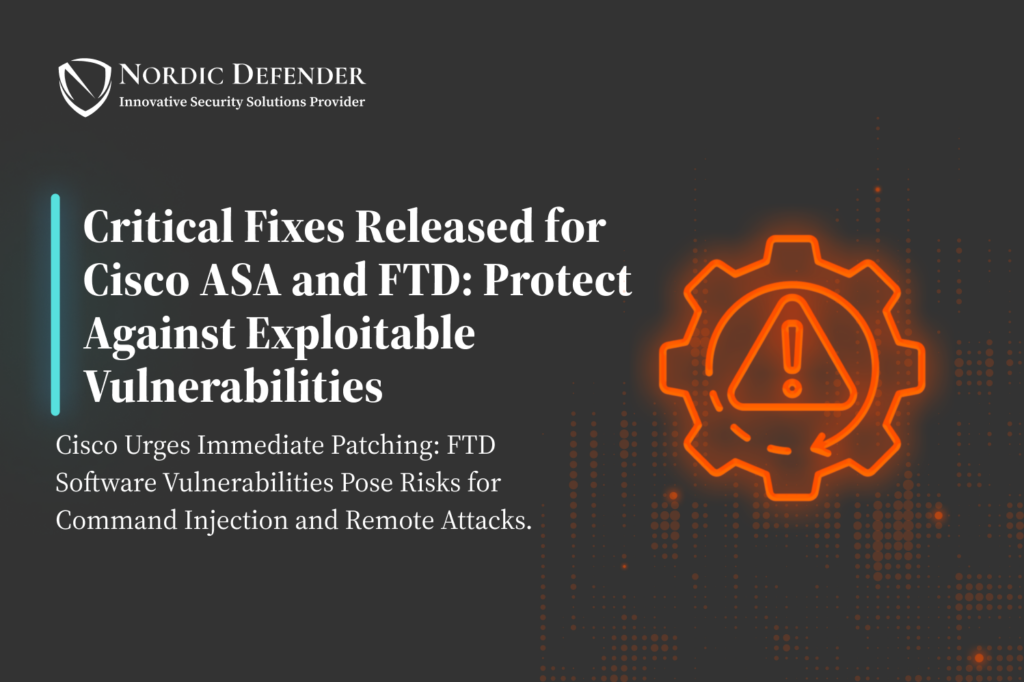Cisco has recently issued crucial updates for its Adaptive Security Appliance (ASA) and Firepower Threat Defense (FTD) products to address multiple high-severity vulnerabilities, including CVE-2024-20481, CVE-2024-20412, CVE-2024-20424, and CVE-2024-20329. These vulnerabilities, if left unpatched, could lead to severe network security risks, particularly as cyberattacks targeting VPNs, remote access points, and management interfaces escalate. This suite of patches strengthens Cisco’s firewall solutions against brute force attacks, unauthorized access, and remote command execution—reinforcing its commitment to enterprise-level security in a rapidly evolving threat landscape.
CVE-2024-20481: Combating VPN Brute Force Attacks
Among these critical updates, CVE-2024-20481 is a key vulnerability, affecting VPN configurations in Cisco ASA and FTD systems, allowing potential brute force attacks. Exploiting this vulnerability could enable attackers to repeatedly attempt login credentials, ultimately gaining unauthorized access to protected networks. Cisco’s patch introduces new protective features, such as automated account lockout mechanisms and rate-limiting, which temporarily block users after a set number of failed login attempts. These defenses effectively neutralize brute force attempts by enforcing time penalties, mitigating the risk of rapid, automated password guessing by attackers.
Additional Critical Vulnerabilities Addressed
Cisco’s latest release also addresses three other critical CVEs that expose various parts of ASA and FTD systems to severe risks if left unpatched. Each of these vulnerabilities poses a distinct threat, and collectively they underscore the importance of prompt and regular patch management.
1. CVE-2024-20412: Static Accounts with Hard-Coded Passwords (CVSS 9.3)
CVE-2024-20412 affects FTD software on Cisco Firepower series appliances, from the 1000 to 4200 Series, due to the presence of static accounts with hard-coded passwords. This vulnerability could allow an unauthenticated, local attacker to gain access using static credentials, presenting a significant risk in environments where physical access to the network is possible. Cisco’s update removes these static accounts, effectively neutralizing the potential for unauthorized access. This vulnerability highlights the importance of designing systems without hard-coded credentials to ensure resilient access management.
2. CVE-2024-20424: Insufficient Input Validation in Web Interface (CVSS 9.9)
The CVE-2024-20424 vulnerability affects the web-based management interface of Cisco Firepower Management Center (FMC) Software. Insufficient input validation of HTTP requests could enable an authenticated, remote attacker to execute arbitrary commands on the operating system as root, granting near-total control over the affected device. Cisco’s patch improves input validation processes, adding necessary checks to prevent command injection attempts. This update is particularly critical for organizations relying on web interfaces for device management, as command execution vulnerabilities can lead to serious network breaches.
3. CVE-2024-20329: Inadequate SSH Input Validation (CVSS 9.9)
CVE-2024-20329 affects the SSH subsystem of ASA, where insufficient validation of user inputs could allow an authenticated, remote attacker to execute operating system commands as root. Attackers exploiting this flaw could bypass standard security protocols, gaining privileged control over the device. Cisco’s patch enhances SSH input validation, ensuring that only trusted commands are processed. Given the popularity of SSH for secure remote access, this patch is essential for securing ASA devices against potential misuse of root privileges by malicious actors.
Practical Steps for Enterprises: Patching, Monitoring, and Best Practices
For organizations utilizing Cisco’s ASA and FTD products, the following steps are crucial in light of these vulnerabilities:
- Apply All Relevant Patches Promptly: Given the severity scores, including two vulnerabilities rated at CVSS 9.9, immediate patching is critical. Delayed updates increase the risk of exploitation, especially for widely used access points like VPNs, SSH, and web-based management interfaces.
- Enable Access Monitoring and Automated Alerts: Cisco’s patch for CVE-2024-20481 includes enhanced login behavior monitoring. IT administrators should leverage this capability to track suspicious patterns such as multiple failed login attempts and other anomalies, allowing swift response to potential threats.
- Adopt Strong Authentication and Access Controls: Ensure that all remote access points, particularly SSH and VPN connections, are protected by multifactor authentication (MFA) and strong password policies. This limits attackers’ ability to exploit brute force attacks, even when vulnerabilities exist.
- Restrict Web Management Access: To mitigate risks associated with CVE-2024-20424, restrict access to the Firepower Management Center’s web interface to internal, secure networks, ensuring it is inaccessible to unauthorized external connections.
The Road Ahead: Cisco’s Continuous Efforts to Secure Enterprise Access Points
Cisco’s multi-pronged patch strategy reflects its commitment to addressing both current and emerging vulnerabilities that target remote access solutions. As hybrid work models continue to rise, securing VPNs, SSH, and web interfaces has become paramount for enterprises worldwide. By addressing vulnerabilities like CVE-2024-20412, CVE-2024-20424, CVE-2024-20329, and CVE-2024-20481 with targeted updates, Cisco demonstrates its ongoing focus on keeping its devices resilient to increasingly sophisticated attacks.
In today’s landscape, where attackers are continuously seeking new exploitation avenues, applying these patches is not just about protecting data; it’s about safeguarding business continuity, brand reputation, and customer trust. The severity of these vulnerabilities highlights the critical nature of regular patching, proactive monitoring, and robust access controls as central pillars of effective cybersecurity.erabilities as they arise. As cyber threats evolve, so too must the defense mechanisms employed by security providers. Cisco’s enhancements to ASA and FTD serve as a reminder of the importance of staying ahead of emerging threats through continuous improvement.
By prioritizing rapid response to threats like CVE-2024-20481 and reinforcing security within its VPN architecture, Cisco reinforces its role as a trusted ally for organizations in need of robust, flexible, and secure remote access solutions.
